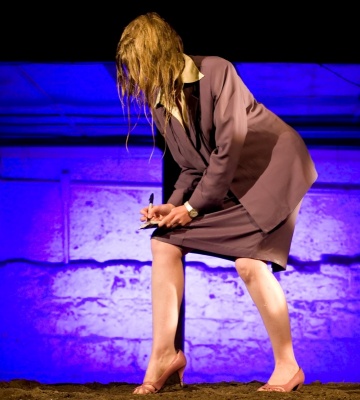Red River | Core
Blue Oyster Art Project Space, Dunedin
18/03/2010 - 18/03/2010
Production Details
Conceived as a one-night performance to be followed by a month-long exhibition at the Blue Oyster Art Project Space, Core appeals to our humanity with the use of tableaux. Moments in this artwork in two parts, tap into the primal; explore the essence of the human; dwell on the liberation of inner nature… If the viewer sees both the performance and the exhibition, the more will be revealed.
The term tableaux in this context may not be self-explanatory, so artist Katrina Thomson clarifies, "the idea is to present a performance work that blurs the boundaries of theatre and performance art. I see this style of work as an installation, which has moving parts. The uses of tableaux or vignettes are like choreographed stand-alone samples of scenes, imagery or action. Seemingly disparate, it is the rhythm of how they are presented that informs the over-all feeling of the work. In a way it can be both cinematic and sculptural.”
Following on from past Fringe Festival performances – Ghost Train, Mothhearts in the Nighthouse, and 3rd Horse – Core showcases local talent and works across the spectrum of potentials in performance and visual art.
Performance: 9pm, Thurs 18 March, 169 High Street
Exhibition Opening: 5:30pm, Tues 23, Blue Oyster Art Project Space
Exhibition Times: 11-5pm Tues – Friday, 12-3pm Saturday until 17 April, Blue Oyster Art Project Space
What lies at the core
Review by Terry MacTavish 05th Apr 2010
Most dramatic and on a larger scale is Red River’s Core, ‘an installation with moving parts’, and winner of Fringe Best Production Design. Directed by Katrina Thomson, creator of last year’s stunning 3rd Horse, the performance is followed up by the exhibition of gorgeous photos of the images created. Either could stand alone, but each gains from its counterpart.
The exhibition in the gallery runs for a month: you go in your own time, you look at what you like for as long as you like. The performance is a one-off, strictly controlled event with the audience herded into an apparently derelict basement in High St, Old Dunedin.
The actor/spectator relationship has been explored in many permutations during Fringe, but for the audience Core presents the most disempowering of all. The venue is pitch-black, and we are admitted only in small groups. We have no notion where we are being led, what we are sitting on, even who is beside or behind us, let alone what we are facing. Right out of our comfort zones, in fact, unsettled and braced for anything.
Out of the absolute darkness comes a wailing sound that develops into drunken singing, the sort that can be heard, loud and uninhibited, on a deserted street late at night, incoherent but full of passion. As it dies away there is at last a gleam of light, and at a considerable distance in the vast space we discern a small circular stage. It could be a fat plinth for a statue, or the trunk of a massive tree that has been felled.
The light fades. When it returns a girl sits motionless on the stage, her arms wrapped round her knees, gazing out of a window. The dark shuts down again. This establishes the pattern by which we are exposed to a succession of arresting tableaux: one or two figures posed on the stage, still or in repetitive motion. All are mysteriously but intently focused, in their activity or their inactivity, on whatever is at the core of their being.
A man shovels earth, a couple dances, a woman in a suit writes frenetically, bare-chested tattooed boxers fight, a woman in pyjamas sleeps sweetly. My favourite is an androgynous figure who carefully scrubs clean a small puffy cloud.
Some of the images are peaceful, some disturbing. Once, the light reveals simply a huge pile of discarded shoes. In our underground dungeon this conjures frightening thoughts of gas chambers. The last image though is hauntingly lovely: thistledown blown softly along a shaft of light.
It is extraordinary how smoothly and silently the choreographed figures appear and disappear from their circular plinth. They establish a hypnotic rhythm of their own, enhanced by music but no words. The lighting is gloriously effective, both on the little stage, and in a luminous wash of colour against the far wall.
The vignettes are a little like a slide show, but so far off they put me more in mind of the diascopes we made as children: shoeboxes with cellophane lids to give a coloured glow, and a peephole to view a scene in miniature, like looking through the wrong end of a telescope. This distancing is effective in itself, but it is frustrating not to be able to read expressions.
Hence the added value of the photographic exhibition on display at the Blue Oyster Gallery. The pictures of the scenes are not only beautiful; they are large enough to provide more detail than was apparent in performance. With the actors’ faces visible, it is possible to interpret more clearly the tableaux presented.
Thomson, assisted by her Red Rivercrew, has yet again displayed remarkable organisational skill: this cannot have been easy to stage. The intense dark, the large empty space with no apparent wings, and the succession of disparate characters present a challenge that is met. Core is a visually gorgeous work. More importantly we are left with the sense of having been led along an intriguing path to expand our own imaginations, and to think a little more deeply about what motivates us, what lies at the core of our own lives.
_______________________________
For more production details, click on the title above. Go to Home page to see other Reviews, recent Comments and Forum postings (under Chat Back), and News.
Copyright © in the review belongs to the reviewer





Comments